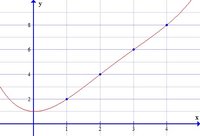jemal.manjgaladze
New member
- Joined
- Jun 9, 2020
- Messages
- 1
Hello .
I am doing some numerical experiment in Physics in university. So I obtained (x,y) pairs from computer calculations and i can draw graph of it using program. but i want to know is there any way or any website so that I input my (x,y) pair and it will give me what function is it?
for example I input (1,2) (2,4) (3,6) (4,8) ... and it gives me f(x)=2x.
I am doing some numerical experiment in Physics in university. So I obtained (x,y) pairs from computer calculations and i can draw graph of it using program. but i want to know is there any way or any website so that I input my (x,y) pair and it will give me what function is it?
for example I input (1,2) (2,4) (3,6) (4,8) ... and it gives me f(x)=2x.

